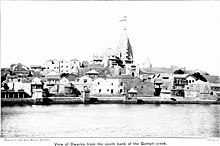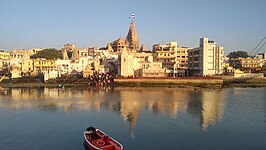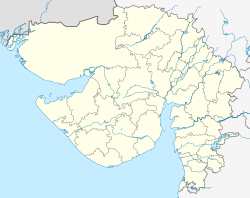DWARKA
Dwarka
This article needs additional citations for verification. (January 2023) |
Dwarka | |
|---|---|
Town | |
Top to bottom: Entrance gate of Dwarka and Dwarkadhish Temple | |
| Coordinates: 22°14′47″N 68°58′00″E | |
| Country | India |
| State | Gujarat |
| Region | Saurashtra |
| District | Devbhoomi Dwarka |
| Founded by | Krishna |
| Government | |
| • Type | Municipality |
| • Body | Dwarka Municipality |
| Elevation | 0 m (0 ft) |
| Population (2011) | |
| • Total | 38,873 |
| Languages | |
| • Official | Gujarati |
| Time zone | UTC+5:30 (IST) |
| PIN | 361335 |
| Vehicle registration | GJ-37 |
| Website | https://devbhumidwarka.nic.in/ |
Dwarka (![]() pronunciation (help·info) ) is a town and municipality of Devbhumi Dwarka district in the state of Gujarat. It is located on the western shore of the Okhamandal Peninsula on the right bank of the Gomti river at the mouth of the Gulf of Kutch facing the Arabian Sea.
pronunciation (help·info) ) is a town and municipality of Devbhumi Dwarka district in the state of Gujarat. It is located on the western shore of the Okhamandal Peninsula on the right bank of the Gomti river at the mouth of the Gulf of Kutch facing the Arabian Sea.
Dwarka has the Dwarkadhish Temple dedicated to Lord Krishna, which is one of four sacred Hindu pilgrimage sites called the Chardham, which were founded by Adi Shankaracharya (686–717 CE) at the four corners of the country, was established as a monastic center and it forms part of the Dwarka temple complex.[1][2] Dwarka is also one of the seven-most-ancient religious cities (Sapta Puri) in India.
Dwarka is part of the "Krishna pilgrimage circuit" which includes Vrindavan, Mathura, Barsana, Gokul, Govardhan, Kurukshetra and Puri.[3] It's one of 12 heritage cities across the country selected under the Heritage City Development and Augmentation Yojana (HRIDAY) scheme of the Government of India to develop civic infrastructure.[4]
The city has a hot, arid climate with a 16-day rainy season. It had a population of 38,873 in 2011. The main festival of [Janmashtami] is celebrated in Bhadrapada (August–September).
History[edit]
Puranic traditions[edit]


Dwarka is considered as the first capital of Gujarat.[2] The city's name literally means gateway.[5] Dwarka has also been referred to throughout its history as "Mokshapuri", "Dwarkamati", and "Dwarkavati".[6] It is mentioned in the ancient epic period of the Mahabharata.[5] According to legend, Krishna settled here after he defeated and killed his uncle Kamsa at Mathura.[7] This mythological account of Krishna's migration to Dwarka from Mathura is closely associated with the culture of Gujarat.[8] Krishna is also said to have reclaimed 12 yojanas or 96 square kilometres (37 sq mi) of land from the sea to create Dwarka.[9]
Dwarka was established as the capital in Saurashtra by the Vedic Indians during the Puranaic.[citation needed] The Yadavas, who had migrated from Mathura, established their kingdom here when the city was known as "Kaushathali". It was during this period that the city underwent rebuilding and was named Dwarka.[10] A friendly population of natives also prompted Krishna to settle at Dwarka when he decided, after fighting Jarasandha, the king of Magadha, to retreat from Mathura. The kingdom, also known as the Yaduvanshi empire, was established by Uugrasena, father of Kansa the then ruler and later Krishna flourished and extended its domain.[11] It is said that Krishna conducted the administration of his kingdom from Dwarka while residing with his family in Bet Dwarka.[12] The city's Dwarkadhish Temple dedicated to Krishna was originally built around 2,500 years ago, but was destroyed by Mahmud Begada rulers and subsequently rebuilt in the 16th century. The temple is also the location of Dwaraka maţha, also called Sharada Matha/Peeth and "western peeth",[13][note 1] one of the four peeths (Sanskrit: "religious center") established by Adi Shankaracharya. As an important pilgrimage centre for Hindus, Dwarka has several notable temples, including Rukmini Devi Temple, Gomti Ghat, and Bet Dwarka. There is also a lighthouse at the land end point of Dwarka.
Archaeology[edit]
Archaeological investigations at Dwarka, both on shore and offshore in the Arabian Sea, have been performed by the Archaeological Survey of India. The first investigations carried out on land in 1963 revealed many artefacts.[14] Excavations done at two sites on the seaward side of Dwarka brought to light submerged settlements, a large stone-built jetty, and triangular stone anchors with three holes. The settlements are in the form of exterior and interior walls, and fort bastions. From the typological classification of the anchors it is inferred that Dwarka had flourished as a port during the period of the Middle kingdoms of India.[9] Coastal erosion was probably the cause of the destruction of what was an ancient port.[9]
Dwarka is mentioned in the copper inscription dated 574 CE of Simhaditya, the Maitraka dynasty minister of Vallabhi. He was the son of Varahdas, the king of Dwarka. The nearby Bet Dwarka island is a religious pilgrimage site and an important archaeological site of the Late Harappan period, with one thermoluminescence date of 1570 BC.[15][16]
Early history[edit]
An epigraphic reference ascribed to Garulaka Simhaditya, the son of Varahdas, the king of Dwarka, is inscribed on a copper plate dated to 574 CE, found in Palitana. The Greek writer of the Periplus of the Erythraean Sea referred to a place called Baraca, which has been interpreted as present-day Dwarka. A reference made in Ptolemy's Geography identified Barake as an island in the Gulf of Kanthils, which has also been inferred to mean Dwarka.[9]
One of the four dhams (religious seats), which were founded by Adi Shankaracharya (686–717 CE) at the four corners of the country, was established as a monastic centre and it forms part of the Dwarka temple complex.[1][2] In 885 CE, the temple was renovated by Nrushinhaashrma, head of the Shankaracharya pitha (centre).[citation needed]
Middle Ages to present[edit]
In 1241, Mohammad Shah invaded Dwarka and damaged the temple. During this battle, five Brahmins (Virajee Thakar, Nathu Thakar, Karasan Thakar, Valjee Thakar, and Devasee Thakar) fought against him, died, and were honoured as martyrs. A shrine was built near the temple in their honour and is known as "Panch Peer", which is a name of Muslim origin.[citation needed]

In 1473 the Gujarat Sultan Mahmud Begada sacked the city and destroyed the temple of Dwarka.[17][18] The Jagat Mandir or the Dwarakadhisa temple was later rebuilt.[19] Vallabha Acharya retrieved an idol of Dwarkadhish, which was revered by Rukmini. He hid it in a stepwell, known as Savitri vav, during the Muslim invasion, before moving it to Ladva village. In 1551, when Turk Aziz invaded Dwarka, the idol was shifted to the island of Bet Dwarka.[citation needed]

Dwarka, along with the Okhamandal region, was under the rule of Gaekwad of Baroda state during the Indian rebellion of 1857. A war broke out at Okhamandal in 1858 between the local Vaghers and the British. The Vaghers had won the battle and ruled until September 1859. Later, after a joint offensive of the British, the Gaekwads, and other princely state troops, the Vaghers were ousted in 1859. During these operations, led by Colonel Donovan, the temples at Dwarka and Bet Dwarka suffered damage and were looted. A complaint of atrocities by the British was made by the local people of Jamnagar, Porbander, and Kutch, which led to their restoration.[20][21][22] In 1861, Dwarakadheesh Temple was renovated by Maharaja Khanderao and the British, who refurbished the shikara.[citation needed] Maharaja Gaikwad of Baroda added a golden pinnacle to the shikara in 1958 during a refurbishment by Shankaracharya of Dwarka. Since 1960, the temple has been maintained by the Government of India.[23]
The Sudama Setu, a bridge over the Gomti River connecting mainland Dwarka with Panchkui island was opened in 2016.[24]





Comments
Post a Comment